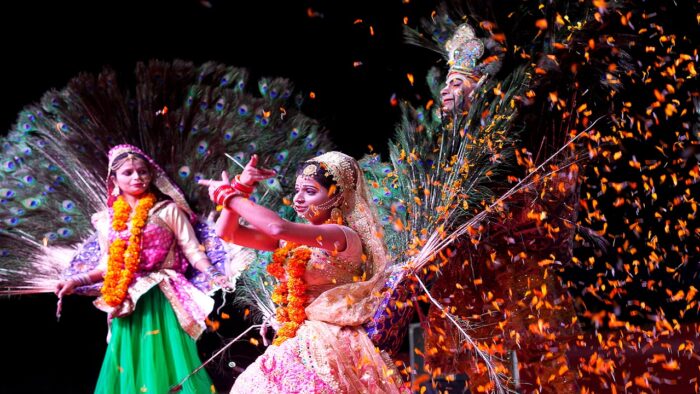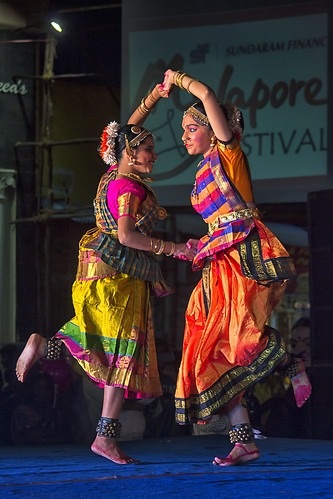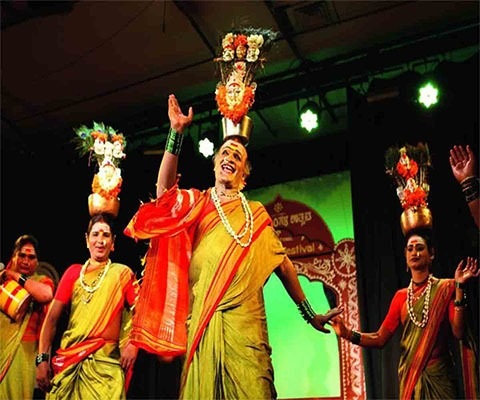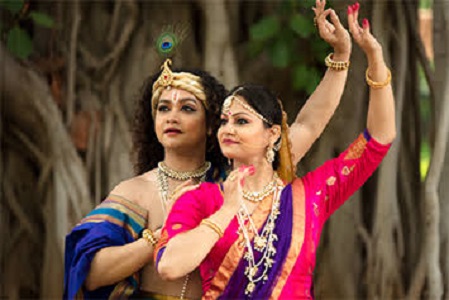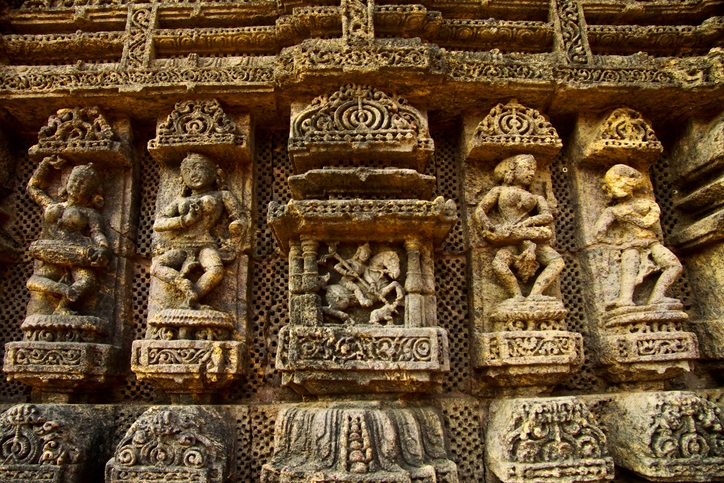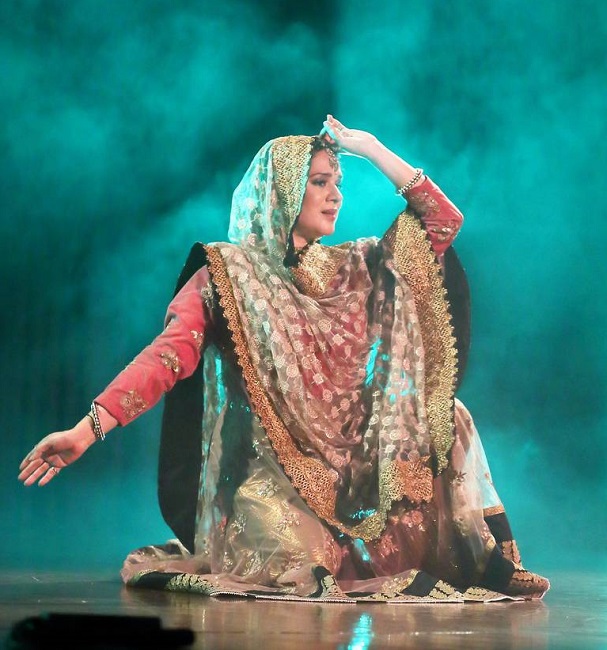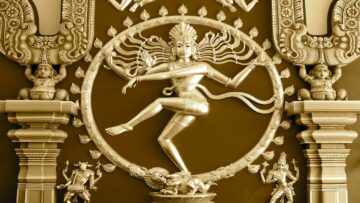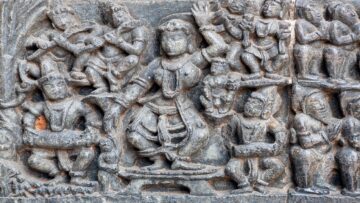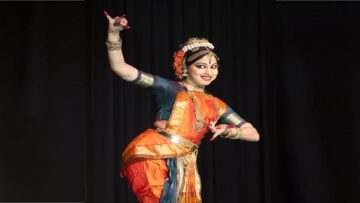From the earliest literature and sculpture, we have evidence of the fine arts being very popular among the general public as well as in the form of performing arts wherein trained professionals took their talents to exceptional levels of skill. As a general assessment and for the scope of this article, we may broadly consider the performing arts in four different contexts: i) social celebrations by participating in music and dance during family functions and festivals, ii) formal theatre in which shows are presented for various audiences, iii) temple dance as a form of worship and iv) court dance for entertainment of the ruling class and other patrons.
I. Dancing at Social and Festive Events
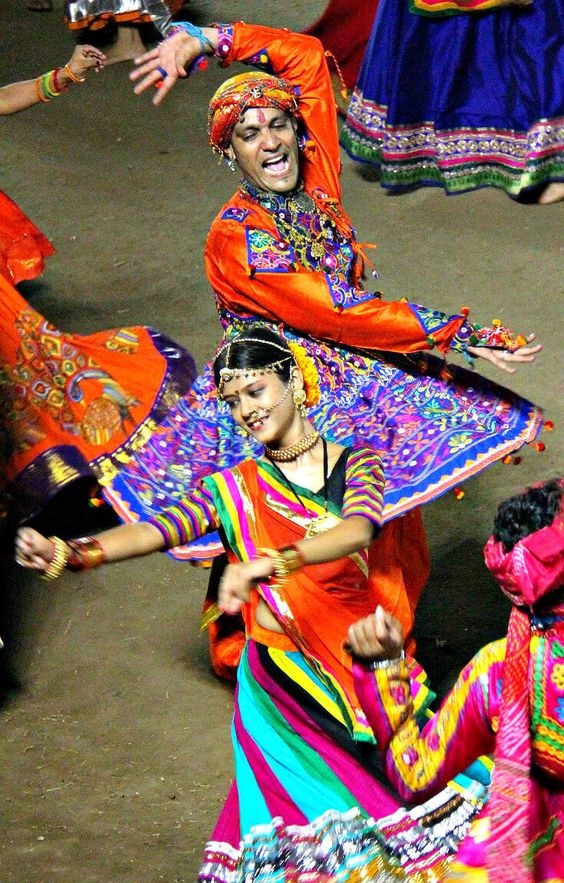 Figure 1: Credit: Pinterest
Figure 1: Credit: Pinterest
(Garba, traditional dance of Gujarat, performed around a clay lantern with a light inside, called a Garbha Deep)
During social gatherings on joyous occasions such as weddings, birthdays, childbirth, coronations, inauguration of a city or building, anniversaries or any special achievements, seasonal celebrations such as spring or equinox, harvest, Teej festival, Navaratri etc., people enjoy good music that fill the air with auspiciousness and good cheer. Dancing is quick to follow – most dances on such occasions are a combination of classical and folk styles, with plenty of room for popular dancing that the uninitiated can join in. This has been a part of Indian culture from the earliest times and we only have to look at dance traditions such as Garbha, Bhangra, Kolatta or Kuravanji, to name a few, to guess at how intricately popular dance has developed since early times.
Figure 2: Credit: Flickriver (Women performing Kuravanji)
Dancing accompanies the most important occasions such as the arrival of the bridegroom, a pilgrimage journey in a group or even a funeral procession. Whenever a large congregation gathers for a celebration, the fine arts find place in a cultured, prosperous society. In the days leading up to a wedding, the Mehndi or Nalangu ceremonies offer opportunity for spa and salon-like pampering for the bride and all others to look their best, which is then followed by a Sangeet ceremony when all the members can showcase their talents in singing and dancing.
Figure 3: Credit: Transnews (Transgenders performing in ceremony invoking blessings for a newborn child)
Trained musicians and dancers, often professionals, were considered to add auspiciousness to such ceremonies and were welcomed among their midst. The performing arts of dance and drama, requiring enormous levels of dedication as well as elaborate costumes and make-up, easily absorbed the transgender community into their fold, a feature we still see in considering their involvement in ceremonies very auspicious for invoking their blessings.
Early poetry and dramatic literature have many references to dance rituals being a part of social events and spring festivals. For instance, Mālavikāgnimitram and Abhijñānaśākuntalam of Kalidasa refer to the Asoka tree flowering in spring only after it is struck ceremonially by a beautifully adorned dancer’s foot. Spring festivals were regarded as harbingers of fertility and prosperity. Epic poetry in prose and verse make innumerable references to the auspicious participation of Gaņikā-s – musicians and dancers – in royal households, e.g., the Rāmayaṇa, Raghuvaṃśa of Kalidasa and Kādambarī of Bana Bhatta.
II. The Theatre of Dance and Drama
Figure 4: Credit: gitagovinda.rhythmsocietyindia (Artists enacting the roles of Radha and Krishna)
Throughout the centuries, performance of dance and drama on the stage for audiences has continued unabated, with many changes as the living tradition evolved. While ten types of Sanskrit theatres were clearly delineated in the Nāṭyasāstra, many adaptations and modifications came into practice over time. Every region had its own variations and specialties. The classical aspect of abhinaya that was expounded in the Nāṭyaśāstra came to be known as Mārgī while the regional improvisations were called Deśī, which are also part of classical repertoire. The latter correspond to the features that identify a dance form as Kathak or Odissi or MohiniAttam, while many common gestures or stances that they share can be recognised as Mārgī. The study of regional styles such as Yakshagana or Kathakali or Chau and the inclusion of vernacular languages make these characteristics clear.
“Margi and Desi are two broad divisions of dance styles. Margi is the classical type of dance as described in the Natyasastra. Desi is developed from Margi, adapting the regional styles of dancing. Desi is an independent style, yet its development is based on the methods of Margi. The development of dance and different forms and variations of it could easily be understood if we bear in mind the linguistic analogy. After classical Sanskrit, there were several Prakrits which also became the media of literary expression. During the course of time they too became sophisticated and standardised. The same applies to the grammar of dance. First the older modes were set forth by Bharata. Then his followers added poses, movements and modes settled as a supplement to the classical repertoire. Although written in regional languages many of them bear Sanskrit names and appear just as a continuation or amplification of the older material….” (Kalarani Ramachandran: p 70)
Figure 5: Credit: theisc.in (Utkanthita Nayika: Radha waiting for Kriśhna)
Drama describes several types of Nāyaka-s and Nāyikā-s, or hero and heroine. The theme of love, depicted by śŗńgāra, which is in fact synonymous with the exuberance of life and not mere physical love, has always been the universal favourite in the world of performing arts; śŗńgāra is certainly the King of Rasa-s. Sanskrit poetry and nāṭya go into great detail in describing the many nuances of love, especially the many phases of the love-lorn nāyikā. The leading lady or nāyikā was classified as Mugdhā (young, innocent and inexperienced), Madhyā (slightly older and moderately experienced) and Prauḍhā (mature and bold in her love) according to age and also as Svakīyā (one’s own), Parakīyā (not one’s own but under someone else’s care) and Sāmānyā (common – such as a courtesan) according to social position.
The Parakīyā refers to young maidens who are unmarried and under the care of parents or guardians in most dramas, but the word also refers to any kind of clandestine love that admittedly creates greater interest in drama. Further, the state of mind in different situations of love in separation and union creates, a mosaic of nāyikā-s described in nāṭya texts to aid the performer in good enactment and representation. These are so popular and interesting that they are often depicted in paintings and sculptures.
There is no doubt that dance and drama have been used for personal gratification and entertainment of patrons, but there are only cursory references to such, as the treatises focused more on the classical style, leaving popular arts to the trends of the times. The nāṭya and sāhityaśāstra texts engaged more with the spiritually uplifting, aesthetic experience of rasa, the sacred aspect of pure dance and the techniques to achieve them. The best form of drama was considered to lead to the delightful aesthetic pleasure of rasa while also imparting moral values. Hence drama was usually based on Purāņa-s and Itihāsa which were meant to illustrate morals and ethics, furthering the teaching of the Vedas. The scope for the nava-rasa-s was created within this framework. Most forms of theatre such as Yakshagana, BhagavataMela, Kathak and Bharatanāṭyam were meant to evoke bhakti among the audience.
III. Temple Dance
Temples were the hub of social, cultural, religious and economic activity, enriching every group of artisans and craftsmen. Seasonal, religious and harvest festivals were occasions for the populace to celebrate life. People from neighbouring villages congregated in temple fairs where there was heightened cultural activity and craftspeople sold their wares. Indian life was defined by vibrant celebration of life’s milestones with pomp and splendour. Indian philosophy has never been an isolated quest for knowledge but was always interconnected with man’s life, suggesting a route that would offer direction and purpose to his existence. As the ultimate goal of life, the highest puruṣārtha, mokṣa is the ideal in tradition that guides humanity through the ordeals of life.
From very early times, even before the construction of temples, worship of images of Gods was popular in many parts of India. Festivals in honour of various deities were well known. Carved images, or even rough-hewn stones or wooden posts representing divinities were worshipped in open places or under trees. Hero-stones were also common and worshipped. Every village or town had patron deities and the crossroads and junction of lanes and streets were a popular place to install these statues. Over time, these must have evolved to temples. Offering flowers, lamps, incense, sandal paste, kuṃkuṃ and vibhūti were early practices. These were not considered as different to Vedic method of worship but considered as practices complementary to Vedic yajña. In fact, we find many such rituals for various purposes in the Atharvaņa Veda — in that sense they are clearly a part of the same Vedic cultural and religious ethos. The Harṣacarita of Bana Bhatta depicts a society that was harmoniously absorbing yajña with many other rituals of worship that were not defined in Vedic practice, even among Brahmin Vaidika communities, as seen in the descriptions of the author’s own hometown (Chapter 2). We have references to Hindu temples in the 1st century CE. Hala’s Gāthā-Saptaśatī (700 Tales) refers to temples of Gauri. Both the epics, Ramayana and Mahabharata refer to temples for Durga, or Devi.
The activities of the temple served not only to attend to the devotional and spiritual needs of the people but also helped in character-building. Participating in organized activities helped people attain a better level of mental and physical discipline, cooperation with other people and a more positive outlook of life. A devotional activity helps people relax, alleviate the cares and worries of life and possibly motivate people for higher meditation and spiritual progress. Devotional music often helps people realize the vastness and eternal nature of the world around, although our own lives are short. Devotion is thus considered a path to broadening one’s horizons.
“What is culture? Perhaps it is one of the over-worked and much-abused words of modern times… Though it is not easy to provide a simple and comprehensive definition of culture, its outstanding features may be mentioned. Intellectual attainment through knowledge and an intellectual awareness and curiosity are fundamental elements of culture. Besides, culture has intimate relations to social habits and customs, behaviour and morals. In fact, culture has a direct bearing on the way of life as well as on the outlook on life. A person’s culture is obviously influenced by one’s parentage, social environment and positive scope for self-improvement provided by education and training. It is in respect of these latter facilities that the temple has proved to be a centre of culture.”
“More positive is the facility for education that the temple provided. During the period when other public agencies like the State had not begun to shoulder the educational responsibility it was primarily the temple and maṭha which provided the facility for education. Many are the inscriptions of medieval times that speak of the educational facilities provided by the temple.” (K.K. Pillai: p 218)
Traditionally the temple also functioned as a centre of learning, particularly in music, dance and scripture. It was an educational and cultural institution in which people from all walks of life – the architect, the sculptor, the painter, the dancer and the musician, the philosopher and the pious, the Paurāņika, poet, all found their place. Among the trained dancers who performed for the deity were both, men as well as women. The vast numbers of scholars, musicians, artistes, poets and composers that the large temples supported in fact constituted well-established music departments that modern universities can scarcely boast. This encouraged the development of specific styles in compositions in different periods under the direction of various masters of outstanding genius.
Figure 6: Credit: istockphoto (Dancing devadasis on temple walls)
The devadāsis were ladies trained in music and dance who were dedicated to the deity in temples. Sometimes girls were offered and dedicated to the temple by their families in their childhood, others were daughters of the community that the temple already supported. It was considered an honour for a family from any walk of life or rank in society, including kings and royalty, to dedicate a young girl in the service of the Lord. The temple undertook to nurture, protect and educate these girls so that when they had attained a certain level of skill in the classical arts of dancing and singing, they could be awarded the title of temple dancer, a coveted position. The devadasis were highly cultured, elegant and skilled in the fine arts, educated in Sanskrit, Purāņic lore and philosophy. In many ways they represented the ideal of Indian womanhood. They were regarded as auspicious harbingers of good fortune in the form of prosperity and fertility. Temple dancing was associated with rituals and on special occasions and festivals, Purāņic episodes that depicted the glory of the Supreme were performed for people to witness. The beautiful sculpture of dancing girls in various poses make the temples of India resound with devotional music and dancing, as such were the cultural activities that filled the halls, representing the various aspects of the cosmos.
Devadāsī-s were considered as wedded to the Lord and regarded as the manifestation of the goddess in human form. Society treated them with great respect; kings and nobility rewarded them with jewellery, land and money for their breathtaking skills in dance. Their presence was considered essential in auspicious ceremonies and festivals. They were not expected to marry and take on domestic responsibilities like other women and yet, celibacy was not imposed on them; some devadasi-s chose their partners while many wedded a partner for life.
In South India, Āgama worship continued longer than it did in the north. All temples had a long association with the devadāsī tradition. Many devadasi-s were considered great devotees of the Lord and some were even regarded as saints, known for their piety and philanthropy in their later years. Of the sixty-four Nāyanmārs in Shaiva tradition, there are a number of women saints many of whom were devadasi-s or Nāciyārs as they are known in Tamil, celebrated for their beauty, skill, devotion and dedication. The Vaishnava tradition also accords great respect to the Nāciyārs who are counted among the greatest devotees.
“The Agamas prescribed a four-fold path for temple service. They were carya, kriyā, yoga and jñāna. Every activity, like the cleaning of temples, singing the Lord’s praise, dancing, reciting hymns, lighting lamps, gathering flowers and making garlands out of them, was sanctioned by the Āgamas as ways to attain salvation. Time and space was sacred entities within the temple. At the centre, the sacred space which symbolised the Universe, stood the deity. It was man’s duty to draw out the correct vibrations from this still centre, to maintain order in an ever-changing world. For example, the Ucchikala puja or mid-day worship was accompanied by the dance of the devadasi. With symbolic hand-gestures, she marked a time measure (tāla) with her feet. A song accompanied her dance, with drums beating the rhythm. This routine was repeated again the next day to herald a new phase in the life of the universe.”
“A prescribed pattern of daily worship was followed in temples for centuries. Even today, while dance is a forgotten factor, this timetable of rituals with singing and playing of instruments is observed in all the big temples.” (Lakshmi Vishwanathan: p 36, 124)
Since dancing before the deity in temples is not permitted anymore by Indian law brought in by the British, the repertoire has moved into the field of dance gurus and Bharatanāṭyam exponents who have revived some of the traditional pieces by learning them from the few remaining Devadasi ladies. These have mostly been possible in Orissa, Andhra Pradesh, Karnataka and Tamil Nadu. For example, Stuti or Kavuthavam was an invocatory piece in praise of the deity. Dance was performed before the sanctum during the daily worship rituals several times a day, sometimes by men and often by women dedicated for this service. During festivals too dance was very sacred and no procession was complete without it. The Agamas specify the worship procedures, giving due importance to dance, sometimes specifying a rāga, tāla and karaņa for a particular deity during the festivities. But usually, the creative freedom was given to the dance gurus and chorographers who followed a tradition handed down from one generation to the next.
As a sample, we look at the Sripraśnasaṃhitā, which is a Vaishnava Agama text that codifies worship rituals in Vishnu temples. In the 39th chapter that speaks of Mahotsava-s, it describes that the Utsava icon of the Lord is taken out on pradosha day after the daily puja and then placed on the vāhana (vehicle) and feted with fragrant oil lamps, all kinds of musical instruments, groups of men-dancers and the graceful dance of women as the procession moves through the streets in a clock-wise direction.
प्रदोषे समनुप्राप्ते नित्यपूजां विधाय च।
ततो वाहनमारोप्य गन्धतैलप्रदीपकैः॥३९।१७॥
Pradoṣesamanuprāptenityapūjāṃvidhāya ca |
Tato vāhanamāropyagandhatailapradīpakaiḥ || 39. 17 ||
सर्ववादित्रसङ्घैश्चनटनर्तकसङ्कुलैः।
नर्तनैर्गणिकानां च प्रादक्षिण्येन वीथिकाः॥३९।१८॥
Sarvavāditrasańghaiścanaṭanartakasańkulaiḥ |
Nartanairgaņikānāṃ ca prādakṣiņyenavīthikāḥ || 39. 18 ||
The suprabhātam ritual of awakening the Lord is mentioned in the 41st Chapter; the Lord is awoken early morning with song, nṛtta (pure dance movements) and musical instruments to begin His daily tasks of the Cosmos, with the priest beginning the day ceremonially by taking the icon out of the night chamber.
गानैर्नृत्तैर्वाद्यभेदैर्वासुदेवंप्रबोधयेत्।
योजयेच्छयनाच्छक्तिं ध्रुवमूर्त्यां ततो गुरुः॥ ४१। ४२ ॥
Gānairnŗttairvādyabhedairvāsudevaṃprabodhayet |
Yojayecchayanācchaktiṃdhruvamūrtyāṃtatoguruḥ || 41. 42 ||
IV. Court Dance
The earliest literature refers to court dances and a complete group of musicians and dancers attached to every court. Undoubtedly there would have been patronage at every level of town and district. In the absence of modern conveniences such as radio, television and recorded music, the public patronage of the fine arts would have been prevalent everywhere. Literature as well as technical treatises record the development of the court entertainment in prosperous kingdoms under generous patrons. While the Nāṭyaśāstra speaks of the same grammar of dance for all types of performances, it recommends creative and judicious use of the techniques, suitable to the context. It is reasonable to imagine that the art of theatre would be used in different ways according to the context, just as the culinary skills of a region would be used differently for daily fare, royal feasts, wedding feasts, festivals or temple ‘prasāda.’
Figure 7 : Credit: thenationalnews (More than just dance girls)
While the lyrics of the music moved to various vernacular languages over time, in North India it became predominantly Hindustani and its various dialects. Court dance and dancing to entertain wealthy patrons were well known as Mujra. The fine arts of poetry and music developed to a fine degree around this performing art. In South India, it was predominantly Telugu, Kannada, Tamil, Malayalam and Maņipravālam (a mixture of Sanskrit and the local language). A few examples from the current field of Bharatanāṭyam reflect the immense variety in dance items from our vast repertoire of different epochs.
Figure 8: (Javali)
The court dances gave scope for an entire range of lyrical composition that has greatly enriched the literary output of several great poets. The name Jāvali, for instance, derives from ‘chāvadi’ in Kannada which means, ‘public space’ where common people gather. These were captivating songs filled with romance, using simple, lucid language. Begun in Kannada in the 15th century, the style became popular in other languages too. Padams were items that focused on conveying tender emotions through abhinaya in graceful lāsya dance that was rich in śŗńgāra rasa. Ashtapadis and other compositions based on Madhura Bhakti were also very popular as they evoked a higher sense of bhakti while presenting the aesthetic motifs of śŗńgāra.
Bibliogaphy
Jayā, Guru Nāṭyavidushi .(2016) NruthyaLakshanam: A Sourcebook on Indian Classical Dance. Jayā Foundation for the Promotion of Performing Arts. Bengaluru.
Narayanan, Sharda & Mohan, Sujatha (2021) Gitagovinda of Jayadeva: Study in Sahitya&Natya. DK Printworld. New Delhi. (second edition)
Padmanabhan, Seetha Ed. (2nd edition 2006, 1st edition 1969) Sriprasnasamhita. RashtriyaSamskritaVidyapeetha. Tirupati.
Pillai,K.K. (1979) Historical Heritage of the Tamils. MJP Publishers. Chennai.
Ramachandran, Kalarani (2004) Bharatanāṭyam in Tamil Nadu (After Aḍ. 1200). Chennai.
Vatsyayan, Kapila (1968) Classical Indian Dance in Literature and the Arts. SangeetNatak Academy. New Delhi.
Vishwanathan, Lakshmi (2008) Women of Pride: The Devadasi Heritage. Lotus Collections, ROLI Books Pvt Ltd. New Delhi.
Feature Image Credit: istockphoto.com
Disclaimer: The opinions expressed in this article belong to the author. Indic Today is neither responsible nor liable for the accuracy, completeness, suitability, or validity of any information in the article.

